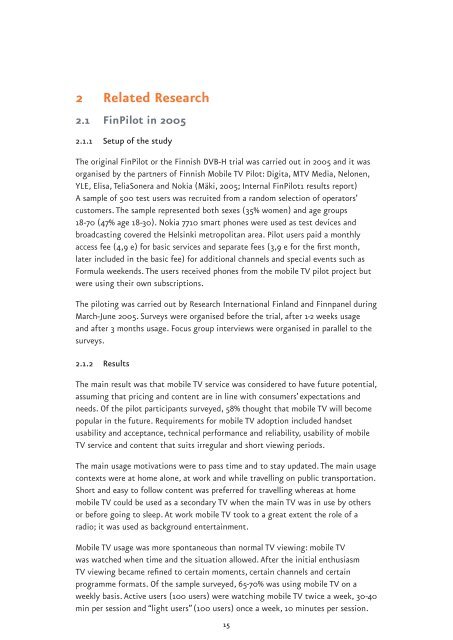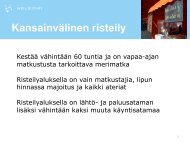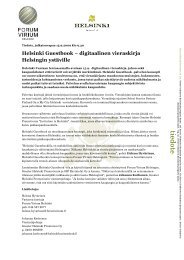FinPilot2 Final Report â User Acceptance of Mobile TV Services ...
FinPilot2 Final Report â User Acceptance of Mobile TV Services ...
FinPilot2 Final Report â User Acceptance of Mobile TV Services ...
You also want an ePaper? Increase the reach of your titles
YUMPU automatically turns print PDFs into web optimized ePapers that Google loves.
2 Related Research<br />
2.1 FinPilot in 2005<br />
2.1.1 Setup <strong>of</strong> the study<br />
The original FinPilot or the Finnish DVB-H trial was carried out in 2005 and it was<br />
organised by the partners <strong>of</strong> Finnish <strong>Mobile</strong> <strong>TV</strong> Pilot: Digita, M<strong>TV</strong> Media, Nelonen,<br />
YLE, Elisa, TeliaSonera and Nokia (Mäki, 2005; Internal FinPilot1 results report)<br />
A sample <strong>of</strong> 500 test users was recruited from a random selection <strong>of</strong> operators’<br />
customers. The sample represented both sexes (35% women) and age groups<br />
18-70 (47% age 18-30). Nokia 7710 smart phones were used as test devices and<br />
broadcasting covered the Helsinki metropolitan area. Pilot users paid a monthly<br />
access fee (4,9 e) for basic services and separate fees (3,9 e for the first month,<br />
later included in the basic fee) for additional channels and special events such as<br />
Formula weekends. The users received phones from the mobile <strong>TV</strong> pilot project but<br />
were using their own subscriptions.<br />
The piloting was carried out by Research International Finland and Finnpanel during<br />
March-June 2005. Surveys were organised before the trial, after 1-2 weeks usage<br />
and after 3 months usage. Focus group interviews were organised in parallel to the<br />
surveys.<br />
2.1.2 Results<br />
The main result was that mobile <strong>TV</strong> service was considered to have future potential,<br />
assuming that pricing and content are in line with consumers’ expectations and<br />
needs. Of the pilot participants surveyed, 58% thought that mobile <strong>TV</strong> will become<br />
popular in the future. Requirements for mobile <strong>TV</strong> adoption included handset<br />
usability and acceptance, technical performance and reliability, usability <strong>of</strong> mobile<br />
<strong>TV</strong> service and content that suits irregular and short viewing periods.<br />
The main usage motivations were to pass time and to stay updated. The main usage<br />
contexts were at home alone, at work and while travelling on public transportation.<br />
Short and easy to follow content was preferred for travelling whereas at home<br />
mobile <strong>TV</strong> could be used as a secondary <strong>TV</strong> when the main <strong>TV</strong> was in use by others<br />
or before going to sleep. At work mobile <strong>TV</strong> took to a great extent the role <strong>of</strong> a<br />
radio; it was used as background entertainment.<br />
<strong>Mobile</strong> <strong>TV</strong> usage was more spontaneous than normal <strong>TV</strong> viewing: mobile <strong>TV</strong><br />
was watched when time and the situation allowed. After the initial enthusiasm<br />
<strong>TV</strong> viewing became refined to certain moments, certain channels and certain<br />
programme formats. Of the sample surveyed, 65-70% was using mobile <strong>TV</strong> on a<br />
weekly basis. Active users (100 users) were watching mobile <strong>TV</strong> twice a week, 30-40<br />
min per session and “light users” (100 users) once a week, 10 minutes per session.<br />
15












